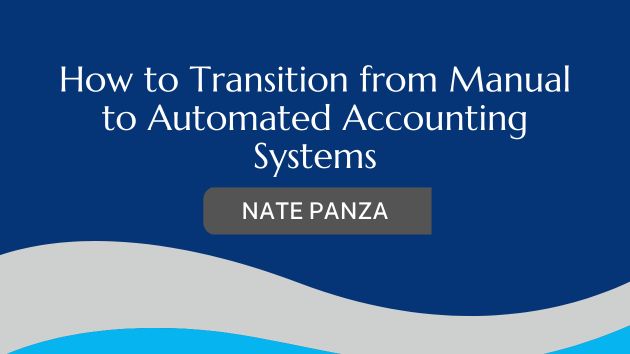In today’s fast-paced business environment, transitioning from a manual to an automated accounting system isn’t just a step forward—it’s a necessity. Manual accounting methods, while reliable in their time, are increasingly being left behind as businesses seek efficiency, accuracy, and real-time financial insights. However, the transition from manual to automated accounting systems can be daunting. Here’s a guide to help you make this shift smoothly and effectively.
1. Assess Your Current Accounting Processes
Before diving into automation, it’s crucial to understand your current manual processes. Conduct a thorough assessment of your accounting workflows, including data entry, reconciliation, reporting, and other financial tasks. Identify areas where manual processes are causing inefficiencies, errors, or delays. This assessment will help you pinpoint the specific needs that automation should address, ensuring you choose the right software and tools for your business.
2. Define Clear Objectives
What do you want to achieve with automation? Whether it’s reducing errors, speeding up financial reporting, or gaining real-time financial insights, having clear objectives will guide your transition. These objectives will also serve as benchmarks to measure the new system’s success. Be specific—consider how much time you want to save on tasks like data entry or how quickly you need reports generated. Clear goals will keep your project focused and on track.
3. Choose the Right Accounting Software
Selecting the right accounting software is critical to a successful transition. There are numerous options on the market, each offering different features, pricing, and scalability. Consider software that integrates seamlessly with your existing systems, is user-friendly, and meets your business needs. Look for features such as real-time reporting, automated data entry, and easy integration with banking systems. Additionally, consider cloud-based solutions, which offer flexibility and scalability as your business grows.
4. Plan the Implementation
Once you’ve chosen your software, create a detailed implementation plan. This should include timelines, key milestones, and a step-by-step process for transitioning each aspect of your accounting. Consider starting with a pilot program, where you test the software with a small portion of your financial data before fully committing. This allows you to identify issues early and adjust your approach if needed. Also, ensure that your plan includes data migration strategies to securely transfer your historical financial data into the new system.
5. Train Your Team
The success of your transition depends heavily on how well your team adapts to the new system. Provide comprehensive training to all users, tailored to their specific roles. Training should cover how to use the new software and how it will change their daily tasks and responsibilities. Consider ongoing support and refresher training as your team becomes familiar with the system. Encouraging open communication during this phase will help address concerns and ensure a smoother transition.
6. Monitor and Adjust
After the initial rollout, closely monitor the system’s performance against your objectives. Pay attention to user feedback, any ongoing challenges, and the system’s impact on your accounting processes. Use this information to make adjustments as needed, whether it’s fine-tuning the software settings, offering additional training, or even re-evaluating certain features. Remember, the transition to an automated system is an ongoing process of refinement and improvement.
7. Leverage the Benefits
Once your automated accounting system is fully operational, could you take full advantage of its capabilities? Use real-time data and analytics to make informed business decisions, streamline financial reporting, and enhance overall financial management. Automation saves time, reduces errors, and provides insights that can drive your business forward.
Conclusion
Transitioning from manual to automated accounting systems is a strategic move that can significantly enhance your business’s efficiency and financial accuracy. By carefully planning each step—from assessment to training and beyond—you can ensure a smooth transition that positions your company for long-term success in an increasingly digital world.

